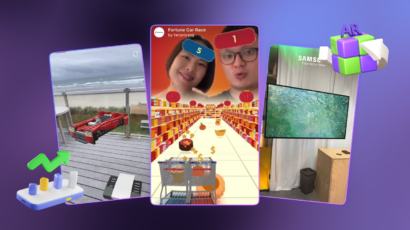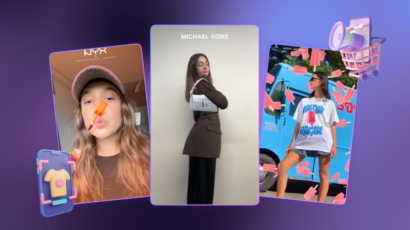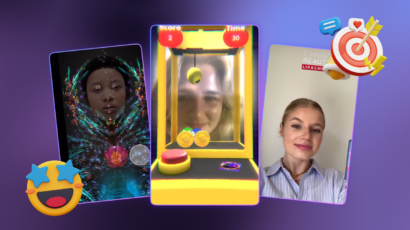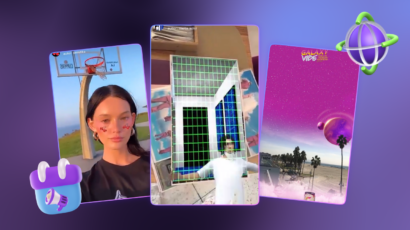You all know that Augmented reality is not just about adding a virtual layer to your next profile picture. AR is transforming how we interact with the physical world, and its applications extend far beyond entertainment. It’s already having a profound impact on a vast array of industries, From the factory floor to the doctor’s office, from the classroom to the furniture store, AR is seamlessly blending the virtual and real worlds with its magic wand. But what about the marketing world? How can marketing agencies leverage the power of AR to create truly groundbreaking campaigns?
73% of mobile AR users report high satisfaction – that’s a statistic no marketer can ignore.
The results? Studies show 30% increase in efficiency within manufacturing and a staggering 75% boost in knowledge retention for education and healthcare. Studies suggest this can lead to a 20% increase in online conversion rates for fashion retailers. 15% rise in sales for cosmetics companies utilising this technology. 10% growth in customer satisfaction within the electronics industry. list is never ending.
So, prepare yourselves. We’ll be diving deep into how various industries are capitalizing on AR’s potential.
Transforming Retail with Image Recognition and Virtual Try-On
In retail, the integration of Image Recognition and Virtual Try-On technologies has revolutionized the shopping experience. Customers can virtually try on clothing, experiment with makeup, or even test out eyeglasses, eliminating the need for traditional fitting rooms. For instance, IKEA Place allows users to visualize furniture in their homes before making a purchase, leading to a 70% increase in conversion rates compared to traditional methods.
The perks of using these technologies are huge.
- Firstly, they cut down on returns since customers can make better-informed decisions about what to buy. This means fewer disappointments for both shoppers and retailers.
- Secondly, they make customers happier because they can confidently choose products that suit their style.
- Lastly, retailers can manage their stock better by understanding what customers want more accurately. This means less waste and more efficient operations. With Image Recognition and Virtual Try-On, retail is becoming more convenient and personalized than ever before.
Empowering Manufacturing
In manufacturing, new technologies like 3D Modeling and Remote Assistance are making tasks easier. Imagine technicians wearing special glasses that show them detailed 3D models of equipment while they work. This helps them put things together and fix problems faster.
For example, if a machine breaks, technicians with these glasses can quickly find out what’s wrong using the 3D models. Studies say using this technology for maintenance can cut down repair times by 30% and make fixing things right the first time 40% more likely
The benefits are huge. Less time spent fixing means more time producing, which is great for business. And with remote assistance, experts can help out without having to be there in person, saving time and money. With these new tools, manufacturing is getting even better.
New ways of Education and Training
In education and training, Spatial Mapping and Portal AR are reshaping how we learn and train. Imagine exploring history through an AR app, where ancient landmarks come to life right from your textbook. It’s like stepping into a time machine, making learning an adventure rather than a chore.
And it’s not just for students. Big players like Boeing are using AR to revolutionize training. Think about it: assembling aircraft is complex, but with AR simulations, trainees can practice in virtual environments, cutting training time by a whopping 40% and boosting memory retention by 50%.
Now, what’s in it for us? Well, these technologies make learning more exciting and effective, leading to better results. They engage students in a way that traditional methods just can’t match. Plus, they’re cost-effective, saving both time and money on training programs. With Spatial Mapping and Portal AR, education and training are stepping into the future, where the possibilities are endless.
Marketing and Advertising
In marketing and advertising, new tech like Interactive Overlays and Location-Based AR are changing how brands connect with their audience. Picture interactive displays in stores where you can explore products up close, learning about them in a whole new way.
And it’s not just in stores. Museums are using AR to guide visitors through exhibits, making learning more interactive and fun. Plus, brands are getting creative with Location-Based AR for things like scavenger hunts, turning everyday spaces into exciting adventures.
The benefits are clear. These technologies make storytelling more immersive, increase customer interaction, and boost campaign effectiveness. With Interactive Overlays and Location-Based AR, marketing is becoming more engaging and impactful than ever before.
Revolution in Architecture and Design
In architecture and engineering, new tech like 3D Modeling and Spatial Mapping is transforming how buildings are designed and constructed. Imagine architects creating detailed 3D models of buildings, then overlaying them onto construction sites using Spatial Mapping. This helps teams visualize the project better and collaborate more effectively.
And it’s not just about visuals. Augmented Reality (AR) can also improve safety by highlighting potential hazards on-site. Workers can see things like underground utilities or structural details in real-time, reducing errors and streamlining workflows.
The benefits are huge. Better communication and collaboration mean projects run smoother. Plus, visualizing designs in 3D helps catch mistakes early, saving time and money. With 3D Modeling and Spatial Mapping, architecture and engineering are entering a new era of efficiency and innovation.
In conclusion, traditional methods can be rigid and costly, causing businesses to miss out on sales and struggle with training. Augmented Reality (AR) provides a flexible solution, allowing companies to achieve more with less. This approach is catching the eye of top companies across various fields. With AR, businesses can better connect with customers, train staff efficiently, and deliver engaging experiences.







